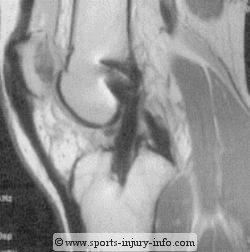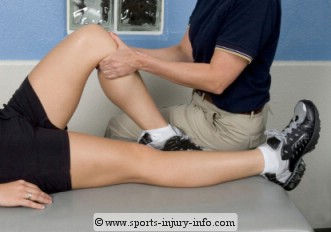ACL Injury Treatment
ACL injury is unfortunately becoming a much more common injury in the world of sports. If you have suffered a torn acl, it may seem very overwhelming at first.
I have good news though... with the treatment
methods today, the
possibility of returning to your sport is very good. Make that great.
It may not seem like it now, but hang in there. You are not alone, and
it will get better.
After an acl injury, the most important thing you can do is to control
your swelling and inflammation. R.I.C.E is the best way to do
this. Rest, ice compression, and elevation. These are your new best
friends.
Applying ice immediately following injury, as
well as resting the injured leg, and using some type of compression
wrap to help control swelling will make your knee feel better, and
help to maintain knee motion. Ice and compression should be
continued as long as you have swelling within your knee.
If you think that you may have suffered an ACL injury, you should see your primary care physician or certified athletic trainer as soon as possible for proper diagnosis and assessment. These professionals are trained to determine the actual injury and its severity, and get you on the right track to recovery.
Symptoms of a Torn ACL

Your physician or athletic
trainer will perform clinical tests to help determine the integrity of
the ACL. These tests, along with your description of how the injury
occurred, how fast it swelled, as well as your other
signs and symptoms
will lead them to determining your exact injury.
Your physician may recommend an MRI (Magnetic Resonance Imaging) in
order to be certain about the diagnosis, and other possible areas of
injury such as the meniscus.
The MRI is a test
that actually takes a
picture of the soft tissues of the body. Todays MRI's are very
accurate, and can help to provide a correct diagnosis.
Learn more about the specific symptoms of a
torn ACL
Starting ACL Rehabilitation
Once you have seen your physician, possibly had an MRI, and the exact
extent of your injury is known, you should be given exercises to
work on to help reduce the swelling, increase your range of motion, and
work on returning you to normal everyday activities.
Ask your physician what you can be doing at home to start getting
better.
Some common exercises include quadricep
sets, which
have you contract your quadriceps
with your leg fully extended, usually holding this contraction for
several seconds. This helps to return strength to your leg, and to
begin a pumping action to move the swelling.
This will not be an easy exercise, but it is important to try it.
Straight
leg raises, towel slides, and hamstring
and calf stretching are also very good exercises to try at
this phase of recovery following ACL injury.
After 1-2 weeks following ACL injury, your swelling
should be diminishing, and your range of motion returning. You will
still feel weakness in your leg, and may have episodes of instability,
where simply walking makes you feel like your knee is going to buckle.
This is very common, and is a result of the ACL no longer being there
to keep the knee stable.
Deciding to Have Surgery
ACL injury is very commonly treated with surgery to reconstruct the
ACL. Once torn, the acl is unlikely to heal on its own. This
is because
the ends of the torn ligament are not usually in close proximation, and
therefore, cannot heal back together. Because this ligament plays a
vital role in knee stability, the decision to have surgery following
ACL injury or to go without is important.
While you may be able to resume normal daily
activities following an ACL injury, sports participation is generally
limited. This is especially true with sports that require quick changes
in direction, such as basketball, football, and soccer. Whether sports
participation is a goal or not, you should also consider the big
picture and the long term health of your knee when deciding about
surgical options for your ACL injury.

The knee joint is made up of several
ligaments and
cartilage that all work together to keep the knee stable. When one of
those ligaments (the ACL) is removed, the knee looses some of its
stability.
The ACL deficient knee is more prone to
abnormal stresses on
the meniscus and other ligaments even with everyday activities like
walking and climbing stairs. As time goes on, the meniscus begins to
degenerate, causing pain and discomfort. Studies have also shown that
arthritic changes occur earlier in life with an untreated ACL injury.
These issues, as well as all of the risks of
surgery, outcomes, and
potential for return to sports should be discussed with your
orthopedist or certified athletic trainer. Make sure you ask your
physician all of your acl questions.
Summary
For most athletes and active people, ACL Reconstruction is a good treatment option following injury to the ACL. With the proper surgery and comprehensive rehabilitation, you can return to an active lifestyle and be able to participate in the activities that you love. However, it is a big decision, and not one that should be taken lightly. Talk with your physician and certified athletic trainer to determine the best course of action for you and your specific situation.
Didn't find what you were looking for? Search SII for more information...Running Pain Solutions
Written for Runners by a runner, you'll learn a holistic approach to improving mobility, restoring normal movement and muscle activation patterns, and restoring the body and mind connection.
This Kindle Book contains a step by step program to keep you running pain free. Included are detailed instructions and illustrations for exercises to improve mobility, balance, neuromuscular control, strength and endurance. Only $7.49!
Get Your Copy Today!









